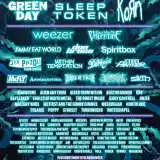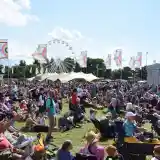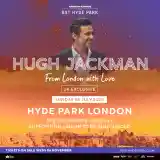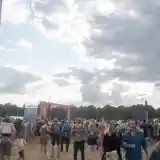Salisbury International Arts Festival 2007
Friday 25th May to Sunday 10th June 2007Various venues, Salisbury, Wiltshire, SP1 2EJ, England MAP
various prices - including free - dependant on event
The 2007 Salisbury International Arts Festival offers festivalgoers a diverse and entertaining programme of music, performance, literature and visual arts. With 2007s artistic focus fixed particularly on Latin culture. Yup, lots of flamboyant dancing, vibrant colours and a selection of world class artists. Theres much to entertain a Salisbury Arts attendee with, not just music but performances, plays, workshops, talks, films and visual arts too.
On the programme this year are such luminaries as Vladimir Ashkenazy, Tasmin Little, Julian Lloyd Webber, Vikram Seth, John Williams, John Etheridge, Paco Peña, George Alagiah, Rosie Boycott, Billy Bragg, Bonnie Langford, Sandi Toksvig, John Major, Simon Sebag Montefiore, Jon Snow and Claire Tomalin.
Also, part of Salisbury International Arts Festival is a traditional ceremony held each year up amongst the old Neolithic circle of Stonehenge. In previous years native people have come and performed ceremonies amongst the stones in front of an audience sitting within the monument.
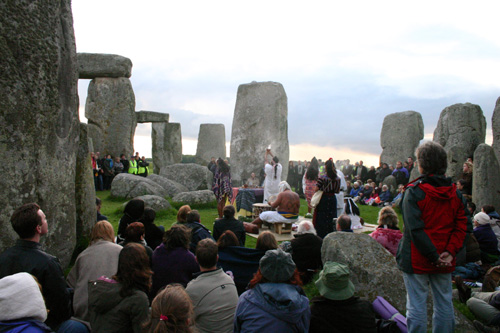
This year Mayan dancers Hamba' Kan (meaning 'Echoes of the Cosmos'), a cultural group from the Itzaes tribe, descendents of the oldest Mayan tribe were performing a traditional sun ceremony (the most sacred event in the Mayan calendar) rarely seen by anyone outside the Yucatan as the sunset between the stones and the full moon rose.
The Mayan race is familiar to us with its astrological systems, fantastical art and ceremonial architecture but I was unsure what to expect as we parked the car and made our way through the cordon and actually in amongst the stones to sit with a couple of hundred others.
The stewards were friendly and suggested places to sit amongst the stones offering a view of the ceremonial altar erected on matting in the centre of the stones. However security werent particularly, following the small audiences every move and asking us not to touch the monument considering access to the stones is rare this surprised me.
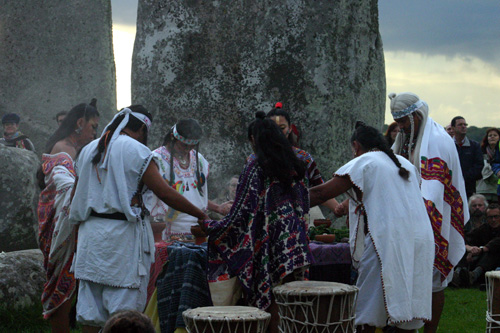
Before the ceremony we were told some background information on these simple farming folk who had travelled thousands of miles to perform the ceremony for us. Unfortunately their quiet voices and an inefficient loud hailer meant we could only hear snatches of the presentation, as the speaker was pointed in various places around the circle.
The air is thick with burning offerings of flowers, incense and herbs smouldering on the table, placed at the five cardinal points East (red) representing the sun, North (white) representing female, South (yellow) representing male, West (black) representing negative, Centre (Blue) is the Altar, representing Mother Earth, the Cosmos, Man and God. Were told all this through the intermittent speaker and as they throw billowing clouds of smoke (used to cleanse or purify the air by the Mayans) around us I was surprised to find it was no smoking when security told me to put my cigarette out.
The ceremony consists of a dance ritual accompanied by chants, drum beats and the sound of the traditional instruments. The group is led by priest Luis Nah, a 17th Generation descendant of the last Chilam Bayam (Mayan Prophet), the musicians perform using traditional hand- Tunkuls, Teponaztles, sea shells, flutes and rattles. The Tankul is considered the most sacred instrument, played only at ceremonies and constructed from bamboo similar to the Philippines drums and said to vibrate in such a way that it enables the body to connect to the cosmos.
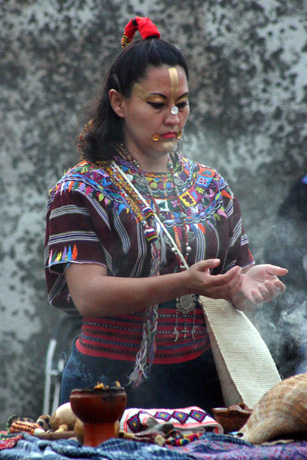
The group enter the circle, lay flowers upon the altar, light more herbs, stand holding hands around the altar and then the priest speaks. The musicians move to stand behind the drums, with a shake of the rattle and a chant the drumming begins, slow and deep it resonates the ribcage. Slowly each instrument is made sacred in the smoke then a large shell is blown at the four directions, accompanied by more smoke and a rattle. Lastly it is taken to the centre, as Luis Nah purifies and then wears a headband an Ocarina looking instrument is blown creating a strange shrieking sound.
Then flutes and various things are offered to the setting sun, hidden in cloud, finally a traditional pipe is offered. The tempo of the chanting and the drumming intensifies; the dancers are smudged (purified in smoke) and then disrobed to dance, while making a noise reminiscent of a cat hissing. Both dancers move with rattles, the tempo increases again and so does the speed of dancing.
The pace increases and then at Luis command the ceremony ends, he re-robes the dancers, they give blessing and then the group gather before us and bow as we applaud. The sun breaks the clouds casting rays between the stones. The group then hand out flowers and Luis presents a member of the audience with a sacred bowl and security unnervingly trail anyone moving.
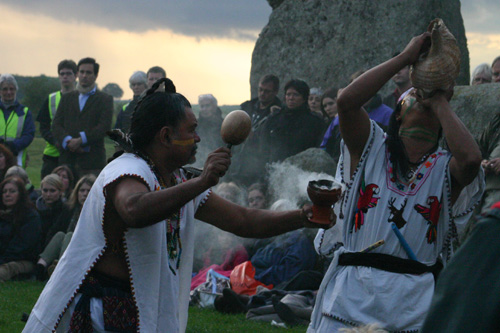
Once it was over, and as the sun dipped below the horizon we made our way back to the car park. The weather had held and it had been fascinating to see such an ancient, simple ritual take place, one, which was probably not dissimilar to those our ancestors performed among the stones. But, even in this short time it really highlighted how much our modern world in coats, blankets and woolly hats and this traditional ancient celebration in very little seemed incredibly at odds with each other in terms of the ritual itself, its smoke, ritual objects, odd percussion, and flute noises that seemed to copy animal sounds and strange song chants.
However their simple dress, their painted bodies, the dancing and the rhythms created by the beat of the drums used to give tribute to the sun seemed less from a lost, forgotten time. They would have not looked so out of place in a field at a summer festival, so perhaps these days our ceremony, dress, dance and rhythms to celebrate the sun arent so dissimilar and merely an evolution of these ancient ceremonies.
review by: Scott Williams
photos by: Karen Williams
Latest Updates
 Salisbury International Arts Festival 2017
Salisbury International Arts Festival 2017festival details
last updated: Wed 10th May 2017
 Salisbury International Arts Festival
Salisbury International Arts Festivalfestival home page
last updated: Wed 24th Aug 2016
 Salisbury International Arts Festival 2016
Salisbury International Arts Festival 2016festival details
last updated: Tue 10th May 2016
 Salisbury International Arts Festival 2015
Salisbury International Arts Festival 2015festival details
last updated: Wed 6th May 2015
 Salisbury International Arts Festival 2014
Salisbury International Arts Festival 2014festival details
last updated: Thu 3rd Apr 2014

